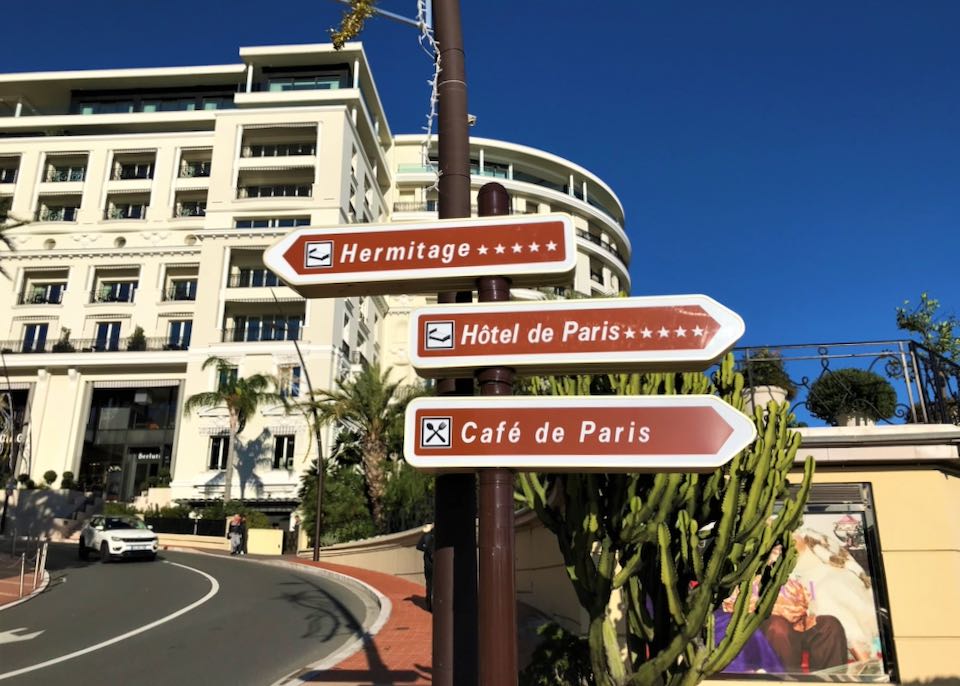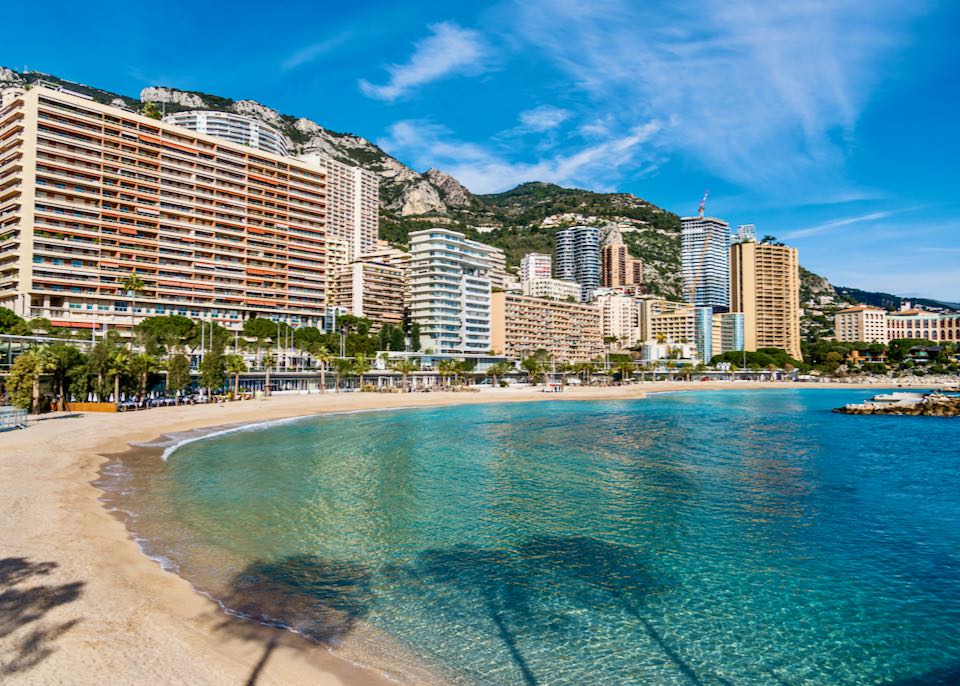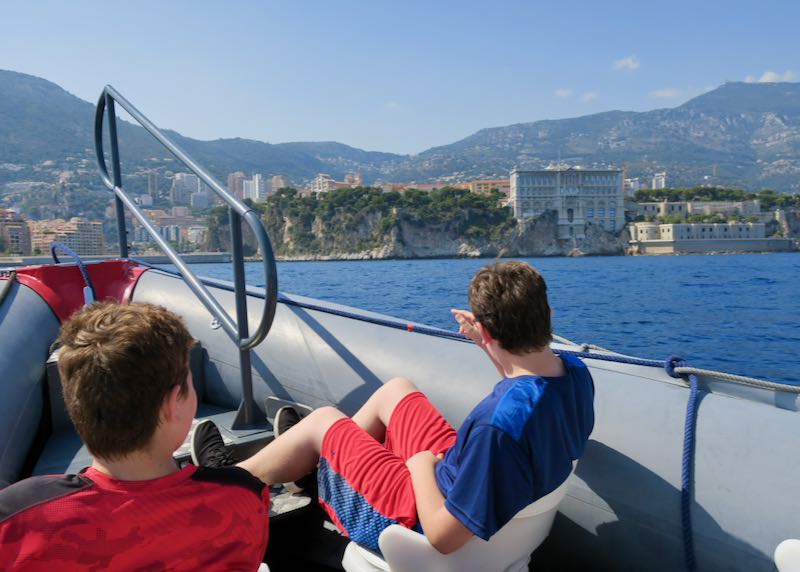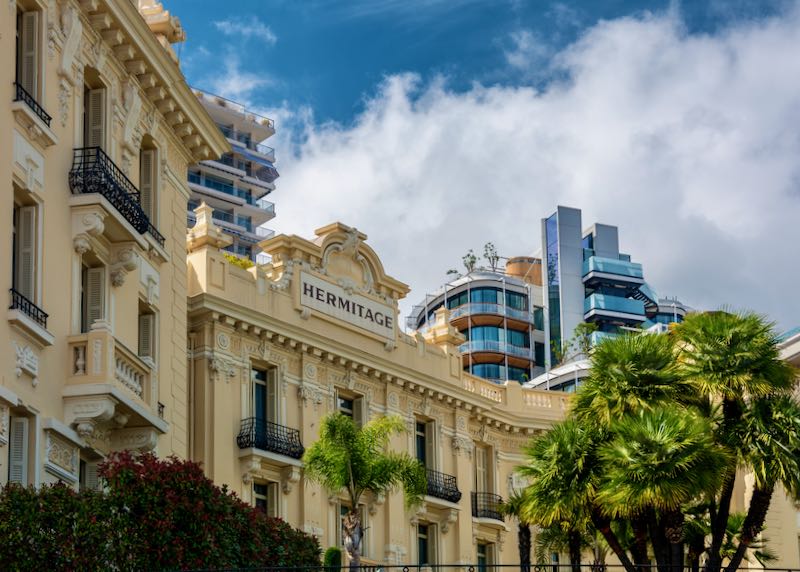
The Hotel de Paris and Hermitage luxury hotels sit across a small street from each other in the Monte Carlo area of Monaco.
The Best Area to Stay in Monaco
Monaco and Monte Carlo are often used interchangeably. It’s an understandable error since they share a tiny footprint along the French Riviera. To clear up the confusion, Monaco is a country or “principality” — the smallest in the world behind the Vatican — and Monte Carlo is the most prominent of its ten sub-districts or wards. Monaco is less than a square mile in size, although the statistic is a bit misleading as the coastline of the rectangular city-state stretches out about 2.5 miles along the Mediterranean. Out of all the wards, Monte Carlo best represents Monaco’s reputation as a playground for the rich with lavish hotels, upscale restaurants, and sweeping waterside scenery – not to mention its infamous reputation as a tax haven.
My boys on a boat tour of the Monaco coast.
Monaco is surrounded on all sides by southeastern France and is also about a half-hour drive from the Italian border, drawing heavy amounts of tourists from both countries. The weather is mild and sunny throughout the year, topping out at about 25℃ (80℉) during the peak of summer. Its identity is shaped by its affluence and history, with the memory of Grace Kelly — an American actress who married into the royal family — held in especially high regard. On name alone, Monaco (and Monte Carlo in particular) can seem intimidating with much of its culture and identity framed around exclusivity. Yet it’s often surprisingly approachable, easy to navigate, and extremely walkable despite the hilly terrain. There’s much to do and see for free, even if restaurants, shops, and hotel rooms often come with out-of-reach price tags. Stroll the docks of Port Hercule, visit the atrium at the Monte Carlo Casino, or relax at numerous gardens and parks. Real estate is scarce and the apartment high-rises are crowded together to maximize space. Yet, Monaco has a timeless quality and aside from a few land reclamation projects, never seems in too much of a rush to reinvent itself. French is the official language, but English and Italian are both used frequently. Americans should note that restaurant menu prices factor in service charges, which is typical of Europe.
If you can afford it, Monte Carlo is the best neighborhood to base your vacation. Centrally located, it’s the most convenient ward for exploring the rest of Monaco and where extravagance is delivered with ample amounts of experience and precision. Hotel de Paris, Hermitage, and Metropole were all built in the late 1800s and their Old World architecture resembles a royal palace more than a hotel. The Fairmont and Novotel are more contemporary and noticeably less expensive. With that being said, don’t hesitate to explore the wards outside Monte Carlo to secure a deal that’s right for you. The entire principality is so efficient and navigable, a vacation is easy to manage from any one of its many corners. Most visitors fly into the Nice airport and take a half-hour shuttle or 15-minute helicopter ride to reach Monaco.
The Best Places to Stay in Monaco
The 5-star Hotel de Paris in central Monaco.
- Best Luxury Hotels in Monaco
Hotel de Paris • Hermitage • Monte Carlo Bay- Best Boutique Hotels in Monaco
Le Meridien Beach Plaza • Novotel • Columbus- Best Cheap Hotels in Monaco
Hotel de France • Hotel Le Quai des PrincesWhere to Stay in Monaco for…
- Best Neighborhoods in Monaco for Walking: Monte Carlo & La Condamine
It would take a lot of grunt work, but Monaco is one of the few countries in the world you could cover in a day by foot — if you really wanted to. With that being said, it’s best to not rush things. That’s especially true in Monte Carlo and La Condamine, a pair of neighboring wards that effortlessly merge together. Explore famous sights like Port Hercule, where lavish yachts dock around the clock, or the Monte Carlo Casino, used as a stylish location for more than one James Bond film. Most tourists skip the gaming and are happy to just roam the atrium and buy a martini (shaken, not stirred) in the themed café. Many restaurants in the area — some expensive, some affordable — have outdoor patios and rooftop decks to soak in the ocean air. Luxury boutiques are around every corner and worth browsing even if you don’t spend a dime.- Best Neighborhood in Monaco for Sight-Seeing: Monaco-Ville
Located at the top of The Rock — an area of high elevation overlooking the Mediterranean — Monaco-Ville is overloaded with history. The best way to see it: take a bus or shuttle to the top and work your way down on foot. Begin with the Prince’s Palace where an official changing of the guard takes place at 11:55 am each day in the square out front. The entire area has a charming Old World feel and is a perfect photo spot for capturing long-distance views of yachts and sailboats in two different ports. Tourists will be drawn to the Oceanographic Museum which combines an aquarium with collections of historic artifacts, and the St. Martin Gardens, a lush environment with tree-lined walking paths, statues, ponds, and sweeping oceanside views. Crowds are allowed to line up and quietly walk through St. Nicholas Cathedral where Prince Rainier, Grace Kelly, and others in the royal family are entombed.

Larvotto Beach in Monaco.
- Best Neighborhood in Monaco for Going to the Beach: Larvotto
Despite its location along the Mediterranean ocean, Monaco has surprisingly few beaches for lounging by the water. The notable exception is Larvotto Beach which dominates the coast north of Monte Carlo. Lined against high-rise hotels and apartments, it’s more of an urban oasis than a remote, tranquil escape. The sand is on the rough side, so make sure to bring a comfortable pair of sandals. Visit the nearby promenade for bars, shops, and restaurants. Of the two hotels in Larvotto, Le Meridien Beach Plaza has its own small private beach and Monte Carlo Bay has a “lagoon” which is basically a pool with a sandy bottom.- Best Neighborhood in Monaco for Gambling: Monte Carlo & Larvotto
The casino culture in Monaco is very different from what Americans typically expect in Las Vegas or Atlantic City. It’s less social and patrons tend to visit with a purpose. The iconic Monte Carlo Casino famously requires a dress code, but the gaming space, which comes with an admission fee, is surprisingly small. The most exclusive areas are behind closed doors. The casinos at the Fairmont and Monte Carlo Bay hotels are much more casual and almost have the feel of boutiques. The Café de Paris, next to the restaurant of the same name, has the most noise and energy — and is far less formal than the others. It’s an easy magnet for tourists.- Best Neighborhood in Monaco for a Locals Vibe: Fontvieille
Built almost entirely from land reclaimed from the sea, Fontvieille is the newest neighborhood in Monaco but one of the least tourist-oriented. The excitement level goes down a notch, but that’s part of the charm. Just take your time while exploring the Princess Grace Rose Garden or the Fontvieille Shopping Centre, which is a mall combined with a grocery store and food court. Mingle with the locals during a football game (or what Americans know as soccer) at Louis II Stadium or dine at the restaurants by the Port of Fontvieille, which is smaller than Port Hercule and a bit more secluded.- Best Neighborhood in Monaco for Shopping: Monte Carlo
Monaco’s affinity for luxury is reflected in the boutiques that line the edges of Place du Casino, the fountain square in front of the Monte Carlo Casino. Splurge on upscale brands among the marble floors and chandeliers of the elegant multi-level shopping plaza at the Metropole hotel or the new ultra-modern Monte Carlo One, a mixed-use development of indoor and outdoor spaces. Even if you can’t afford much, the window shopping is a spectacle all by itself.- Best Neighborhood in Monaco for Nightlife: Larvotto & Monte Carlo
The most famous nightclub in Monaco is Jimmy’z. The iconic party spot has been around for decades and was renovated in recent years to make the most of the outdoor scenery at the Monte Carlo Bay resort. Twiga, Sass Café, and Caviar Kaspia are a trio of restaurants with a thriving late-night scene by Larvotto Beach. Closer to the heart of Monte Carlo, Buddha Bar favors a dark and seductive image, while Nikki Beach plays up a dayclub atmosphere on the rooftop pool deck at the Fairmont. If dance music isn’t your thing, Le Bar Américain is a cozy Roaring ’20s-style jazz club in the lobby of Hotel de Paris. Otherwise, you’re a short walk away from La Rascasse, a multi-level bar with a strong local vibe that overlooks Port Hercule.- Safest Areas of Monaco
There’s little to worry about when it comes to safety. Monaco is known for having less crime than any other European nation. Monte Carlo, the most upscale ward, has the greatest sense of security and there’s little to worry about while navigating Monaco-Ville or even Larvotto Beach.- Unsafe Areas of Monaco
There really isn’t a neighborhood considered “unsafe” in Monaco. The occasional pickpocket is probably the biggest concern for any tourist, so just be vigilant of your belongings when navigating crowded areas in Monte Carlo and Monaco-Ville. The streets and parks of Fontvieille can seem dark and quiet at night, and while not dangerous, there really isn’t a reason for visitors to be there after sundown. The same goes for the inland wards dominated by apartment high-rises.The 6 Best Neighborhoods in Monaco for Tourists
The Hermitage hotel in Monaco.
1. Monte Carlo
Centrally located in the heart of Monaco, Monte Carlo is where the country sparkles most. Its main attraction is the Monte Carlo Casino, which feels like a museum and has a small café that plays up its connection to James Bond movies. Exotic cars are famously parked along the streets and lavish boutiques are easy to find at Metropole or Monte Carlo One. Some of the side streets and alleyways are tight and tucked out of the way, opening up the opportunity for fun, off-beat discoveries like the figurines at Toys Collection, the pizza at Flashman’s, and the scenic Gardens of Little Africa park. However, if you want to splurge, Alain Ducasse’s Le Louis XV is considered one of the best fine dining restaurants in the world.
- Best Hotels: Hotel de Paris • Hermitage • Metropole
- Best Cheap/Moderate Hotels: Fairmont • Novotel
2. Monaco-Ville
A hot spot for tourists, Monaco-Ville is where you’ll find the royal palace, formerly a historic fortress that’s now home to Prince Albert II. Tours are available, but lines are long and the interior isn’t especially compelling. Seeing the daily ceremonial changing of the guard is a spectacle and a Monaco bucket list activity, although it may be hard to get a good view if crowds are heavy. Monaco-Ville (or “Monaco City” if you go with strict English) sits on The Rock of Monaco, an area of high elevation by the water. The views are incredible, especially of Port Hercule to the north. You’ll probably take most of your photos here. The district is the oldest part of Monaco and has an old village feel. Make a point to visit the Oceanographic Museum where Jacques Cousteau served as director for decades, historic St. Nicholas Cathedral, and the scenic St. Martin Gardens that overlook the Mediterranean while sloping down the mountainside. The shops here are modest and tourist-oriented compared to the upscale boutiques of Monte Carlo.
3. La Condamine & Les Moneghetti
La Condamine is the direct area surrounding Port Hercule, with much of its identity shaped by maritime culture and the lavish yachts that float among the docks. Security is minimal, which allows any tourist to see the boats up close and experience a taste of what it’s like to live like the one percent. The Yacht Club, built in the shape of a large boat, is strictly members-only, however. La Rascasse is a 2-level bar with a patio on the water that’s popular with locals. Stars ‘n’ Bars is targeted toward Americans with steaks and burgers. Fort Antoine is an open-air theater converted from an old fortress. Take advantage of the scenery with a variety of water tours and cruises. If you want to keep things simple (and save time on walking), solar-powered water taxis travel from one side of the port to the other. Neighboring Les Moneghetti is less scenic but features more mainstream shopping, Monaco’s only train station, and the cliffside Exotic Garden, an engaging spot with cave tours and views of the city.
- Best Hotels: Port Palace • Ambassador
- Best Cheap/Moderate Hotel: Hotel de France
4. Fontvieille
Fontvieille is where Monaco suddenly seems less opulent, although seeing how the locals live is uniquely fascinating in a country known for wealth and luxury. The subsidized public housing in the neighborhood (available to anyone with a Monaco passport) would pass for higher-end apartments in other locales. The Fontvieille Shopping Centre (or Terrasses de Fontvieille) is a locals-oriented shopping mall and a change of pace from the tourist trappings that dominate the rest of Monaco. The one exception is the Top Cars Collection, a museum featuring automobiles once owned by Prince Rainier. Fontvieille has a harbor that’s smaller and more modest than Port Hercule on the other side of The Rock. Catch a football game at Louis II Stadium, which almost blends in unnoticed among the neighborhood architecture, or stroll through the Princess Grace Rose Garden and watch aircraft take off and land at the nearby heliport.
- Best Hotels: Riviera Marriott • Columbus
- Best Cheap/Moderate Hotels: Le Quai des Princes
5. Larvotto & La Rousse
Just north of Monte Carlo, Larvotto isn’t quite as glamorous, but still feels very much like a vacation destination with a stretch of beachfront lined by a promenade with shops and bistros. The ward’s 2 hotels include the modern boutique-style Le Meridien Beach Plaza and Monte Carlo Bay, a larger contemporary resort next to Jimmy’z nightclub and the Sporting Club (an event space and concert hall with a retractable roof). Northwest of Larvotto, La Rousse is more residential and a good place to find short-term apartment rentals. Tour Odeon, the tallest and newest high-rise in Monaco, is a striking contrast to the grittier architecture surrounding it.
- Best Hotels: Monte Carlo Bay • Le Meridien Beach Plaza
- Best Cheap/Moderate Hotel: Independent apartment rentals
6. Beyond the Borders
Sometimes, it’s hard to feel like Monaco isn’t simply another part of France. Driving (or even walking) across the borders of the 2 countries comes without checkpoints or much fuss at all — although police often make their presence felt as a subtle reminder. Take advantage of the loose diplomacy by exploring hotels and restaurants in nearby French territory. The winding mountain roads of Cote d’Azur lead to vineyards and ski slopes. Eze, La Turbie, and Gourdon are small villages that often feel like a trip back to Medieval times. Nice is about a 30-minute drive to the south, while the Italian border is about the same distance to the north. Of course, almost any destination on the French Riviera will have a fair amount of pastel architecture, historic sights, and mild weather to complement an easy seaside lifestyle.
- Best Hotels: Monte-Carlo Beach • Cap-Estel
- Best Cheap/Moderate Hotels: Olympia • Hotel de Monaco
Saving Money in Monaco
Monaco is known as a playground for the filthy rich, but it’s still possible to enjoy the destination on a budget. Use a few of the following strategies to make the most of your dollars — or more accurately, your euros. Don’t try to pull off a cheap vacation. It’s not the place for that. Instead, direct your resources to what’s most important to you while saving money elsewhere.
- Take the Bus around Town
Hop on hop off bus tours aren’t uncommon in tourist destinations, but the concept is especially effective in Monaco. Cover nearly every inch of the principality with Le Grand Tour via a double-decker bus route that runs regularly through the day. It’s especially useful for reaching the top of The Rock or skipping the less enchanting areas of Fontvieille. Get off, walk for a while, and hop back on near a stop that’s always just a few minutes away. There is also an official public bus system with less expensive day passes.- Tie Your Visit into a Cruise
Monte Carlo is a popular stop for numerous cruises along the French Riviera, allowing tourists to visit for hours with no need to worry about booking a hotel room. Maximize time with an outdoor escalator to the top of The Rock that’s convenient to where cruise ships usually dock. A stop in Monaco is common for numerous cruises connecting West Mediterranean destinations like Rome, Venice, Barcelona, and Casablanca. If you prefer to stay on land while exploring Europe, Monaco has a train station that connects to routes throughout France and Italy.- Skip the Casinos
Almost everyone wants to have their photo taken at the Monte Carlo Casino, Monaco’s most famous landmark. However, you can avoid the temptation to gamble and blow a chunk of your vacation budget by sticking with a quick visit to the lobby atrium. It’s usually enough to get a taste of what it’s like inside and you’ll avoid the entrance fee. Otherwise, gambling is relatively easy to avoid, since there are only 3 other fully operational casinos to visit in Monaco and they’re not omnipresent like in Las Vegas or Macau. In an interesting twist, Monaco citizens are actually prohibited by law to enter a casino. It’s a wise example to follow if you don’t have “play money” you can afford to lose.- Dine Wisely
Monaco has amazing bucket-list restaurants from Europe’s most acclaimed chefs — most notably Alain Ducasse’s Le Louis XV at Hotel de Paris (3 Michelin stars) and Joel Robuchon at Metropole (2 Michelin stars). Both specialize in multi-course meals that come with large checks. If you’re not quite ready to pull the trigger, try Elsa (1 Michelin star) just outside the Monaco border at the Monte Carlo Beach hotel. (You can walk to it easily from Larvotto, barely noticing you’re going from one country to another.) The dining room is cozy and intimate, and the ingredients are all organic, presented in multi-course dinners that still feel like an experience. Another great alternative is Odeon Café in the Tour Odeon skyscraper which serves Italian cuisine by the Cipriani family in a more approachable setting.- Visit Off-season
Save some money by avoiding the busier times of year in Monaco which tend to be in the warmer spring and summer months. The Rolex Monte Carlo Masters tennis tournament in April, the iconic F1 Monaco Grand Prix (driven on city streets) in May, and the Fete de la Mer and St. John’s Festival, which both take place in June, are all big draws. Avoid visiting during these events and you’ll take advantage of less expensive hotel rates.



About Santorini Dave